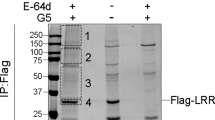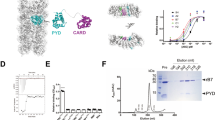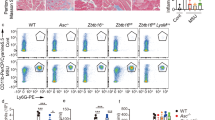Abstract
The inflammasome adaptor ASC contributes to innate immunity through the activation of caspase-1. Here we found that signaling pathways dependent on the kinases Syk and Jnk were required for the activation of caspase-1 via the ASC-dependent inflammasomes NLRP3 and AIM2. Inhibition of Syk or Jnk abolished the formation of ASC specks without affecting the interaction of ASC with NLRP3. ASC was phosphorylated during inflammasome activation in a Syk- and Jnk-dependent manner, which suggested that Syk and Jnk are upstream of ASC phosphorylation. Moreover, phosphorylation of Tyr144 in mouse ASC was critical for speck formation and caspase-1 activation. Our results suggest that phosphorylation of ASC controls inflammasome activity through the formation of ASC specks.
This is a preview of subscription content, access via your institution
Access options
Subscribe to this journal
Receive 12 print issues and online access
$209.00 per year
only $17.42 per issue
Buy this article
- Purchase on Springer Link
- Instant access to full article PDF
Prices may be subject to local taxes which are calculated during checkout








Similar content being viewed by others
References
Martinon, F., Mayor, A. & Tschopp, J. The inflammasomes: guardians of the body. Annu. Rev. Immunol. 27, 229–265 (2009).
Brodsky, I.E. & Monack, D. NLR-mediated control of inflammasome assembly in the host response against bacterial pathogens. Semin. Immunol. 21, 199–207 (2009).
Davis, B.K., Wen, H. & Ting, J.P. The inflammasome NLRs in immunity, inflammation, and associated diseases. Annu. Rev. Immunol. 29, 707–735 (2011).
Dinarello, C.A. Immunological and inflammatory functions of the interleukin-1 family. Annu. Rev. Immunol. 27, 519–550 (2009).
Miao, E.A. et al. Innate immune detection of the type III secretion apparatus through the NLRC4 inflammasome. Proc. Natl. Acad. Sci. USA 107, 3076–3080 (2010).
Franchi, L. et al. Cytosolic flagellin requires Ipaf for activation of caspase-1 and interleukin 1β in salmonella-infected macrophages. Nat. Immunol. 7, 576–582 (2006).
Miao, E.A. et al. Cytoplasmic flagellin activates caspase-1 and secretion of interleukin 1beta via Ipaf. Nat. Immunol. 7, 569–575 (2006).
Boyden, E.D. & Dietrich, W.F. Nalp1b controls mouse macrophage susceptibility to anthrax lethal toxin. Nat. Genet. 38, 240–244 (2006).
Franchi, L., Munoz-Planillo, R., Reimer, T., Eigenbrod, T. & Nunez, G. Inflammasomes as microbial sensors. Eur. J. Immunol. 40, 611–615 (2010).
Mariathasan, S. et al. Cryopyrin activates the inflammasome in response to toxins and ATP. Nature 440, 228–232 (2006).
Kanneganti, T.D. et al. Critical role for Cryopyrin/Nalp3 in activation of caspase-1 in response to viral infection and double-stranded RNA. J. Biol. Chem. 281, 36560–36568 (2006).
Martinon, F., Petrilli, V., Mayor, A., Tardivel, A. & Tschopp, J. Gout-associated uric acid crystals activate the NALP3 inflammasome. Nature 440, 237–241 (2006).
Li, H., Nookala, S. & Re, F. Aluminum hydroxide adjuvants activate caspase-1 and induce IL-1beta and IL-18 release. J. Immunol. 178, 5271–5276 (2007).
Rathinam, V.A. et al. The AIM2 inflammasome is essential for host defense against cytosolic bacteria and DNA viruses. Nat. Immunol. 11, 395–402 (2010).
Fernandes-Alnemri, T. et al. The AIM2 inflammasome is critical for innate immunity to Francisella tularensis. Nat. Immunol. 11, 385–393 (2010).
Tsuchiya, K. et al. Involvement of absent in melanoma 2 in inflammasome activation in macrophages infected with Listeria monocytogenes. J. Immunol. 185, 1186–1195 (2010).
Kim, S. et al. Listeria monocytogenes is sensed by the NLRP3 and AIM2 inflammasome. Eur. J. Immunol. 40, 1545–1551 (2010).
Fang, R. et al. Critical roles of ASC inflammasomes in caspase-1 activation and host innate resistance to Streptococcus pneumoniae infection. J. Immunol. 187, 4890–4899 (2011).
Kerur, N. et al. IFI16 acts as a nuclear pathogen sensor to induce the inflammasome in response to Kaposi sarcoma-associated herpesvirus infection. Cell Host Microbe 9, 363–375 (2011).
Masumoto, J. et al. ASC, a novel 22-kDa protein, aggregates during apoptosis of human promyelocytic leukemia HL-60 cells. J. Biol. Chem. 274, 33835–33838 (1999).
Case, C.L., Shin, S. & Roy, C.R. Asc and Ipaf Inflammasomes direct distinct pathways for caspase-1 activation in response to Legionella pneumophila. Infect. Immun. 77, 1981–1991 (2009).
Bryan, N.B., Dorfleutner, A., Rojanasakul, Y. & Stehlik, C. Activation of inflammasomes requires intracellular redistribution of the apoptotic speck-like protein containing a caspase recruitment domain. J. Immunol. 182, 3173–3182 (2009).
Fernandes-Alnemri, T. et al. The pyroptosome: a supramolecular assembly of ASC dimers mediating inflammatory cell death via caspase-1 activation. Cell Death Differ. 14, 1590–1604 (2007).
Guarda, G. et al. Type I interferon inhibits interleukin-1 production and inflammasome activation. Immunity 34, 213–223 (2011).
Mayor, A., Martinon, F., De Smedt, T., Petrilli, V. & Tschopp, J. A crucial function of SGT1 and HSP90 in inflammasome activity links mammalian and plant innate immune responses. Nat. Immunol. 8, 497–503 (2007).
Franchi, L. et al. Calcium-independent phospholipase A2β is dispensable in inflammasome activation and its inhibition by bromoenol lactone. J. Innate Immun. 1, 607–617 (2009).
Qu, Y. et al. Phosphorylation of NLRC4 is critical for inflammasome activation. Nature 490, 539–542 (2012).
Gross, O. et al. Syk kinase signalling couples to the Nlrp3 inflammasome for anti-fungal host defence. Nature 459, 433–436 (2009).
Shio, M.T. et al. Malarial hemozoin activates the NLRP3 inflammasome through Lyn and Syk kinases. PLoS Pathog. 5, e1000559 (2009).
Chuang, Y.T. et al. Tumor suppressor death-associated protein kinase is required for full IL-1β production. Blood 117, 960–970 (2011).
Kankkunen, P. et al. (1,3)-beta-glucans activate both dectin-1 and NLRP3 inflammasome in human macrophages. J. Immunol. 184, 6335–6342 (2010).
Lu, B. et al. Novel role of PKR in inflammasome activation and HMGB1 release. Nature 488, 670–674 (2012).
Wong, K.W. & Jacobs, W.R. Jr. Critical role for NLRP3 in necrotic death triggered by Mycobacterium tuberculosis. Cell Microbiol. 13, 1371–1384 (2011).
Stehlik, C. et al. The PAAD/PYRIN-only protein POP1/ASC2 is a modulator of ASC-mediated nuclear-factor-κB and pro-caspase-1 regulation. Biochem. J. 373, 101–113 (2003).
Kosako, H. et al. Phosphoproteomics reveals new ERK MAP kinase targets and links ERK to nucleoporin-mediated nuclear transport. Nat. Struct. Mol. Biol. 16, 1026–1035 (2009).
Kurokawa, M. & Kornbluth, S. Caspases and kinases in a death grip. Cell 138, 838–854 (2009).
Sumbayev, V.V. & Yasinska, I.M. Role of MAP kinase-dependent apoptotic pathway in innate immune responses and viral infection. Scand. J. Immunol. 63, 391–400 (2006).
Balci-Peynircioglu, B. et al. Expression of ASC in renal tissues of familial mediterranean fever patients with amyloidosis: postulating a role for ASC in AA type amyloid deposition. Exp. Biol. Med. (Maywood) 233, 1324–1333 (2008).
Villani, A.C. et al. Common variants in the NLRP3 region contribute to Crohn's disease susceptibility. Nat. Genet. 41, 71–76 (2009).
Zaki, M.H. et al. The NLRP3 inflammasome protects against loss of epithelial integrity and mortality during experimental colitis. Immunity 32, 379–391 (2010).
Jin, Y. et al. NALP1 in vitiligo-associated multiple autoimmune disease. N. Engl. J. Med. 356, 1216–1225 (2007).
Vandanmagsar, B. et al. The NLRP3 inflammasome instigates obesity-induced inflammation and insulin resistance. Nat. Med. 17, 179–188 (2011).
Duewell, P. et al. NLRP3 inflammasomes are required for atherogenesis and activated by cholesterol crystals. Nature 464, 1357–1361 (2010).
Pope, R.M. & Tschopp, J. The role of interleukin-1 and the inflammasome in gout: implications for therapy. Arthritis Rheum. 56, 3183–3188 (2007).
Hara, H. et al. The adaptor protein CARD9 is essential for the activation of myeloid cells through ITAM-associated and Toll-like receptors. Nat. Immunol. 8, 619–629 (2007).
Cao, Y. et al. Enhanced T cell-independent antibody responses in c-Jun N-terminal kinase 2 (JNK2)-deficient B cells following stimulation with CpG-1826 and anti-IgM. Immunol. Lett. 132, 38–44 (2010).
Turner, M. et al. Perinatal lethality and blocked B-cell development in mice lacking the tyrosine kinase Syk. Nature 378, 298–302 (1995).
Hara, H. et al. Dependency of caspase-1 activation induced in macrophages by Listeria monocytogenes on cytolysin, listeriolysin O, after evasion from phagosome into the cytoplasm. J. Immunol. 180, 7859–7868 (2008).
Lutz, M.B. et al. An advanced culture method for generating large quantities of highly pure dendritic cells from mouse bone marrow. J. Immunol. Methods 223, 77–92 (1999).
Acknowledgements
We thank J. Tschopp and the Institute for Arthritis Research for permission to use Nlrp3−/− mice; S.Taniguchi (Shinshu University) for Pycard−/− mice; K. Kuida (Millennium Pharmaceuticals) for Casp1−/− mice; T. Saito (RIKEN RCAI) for Card9−/− mice; K. Kawasaki (Doshisha Women's College) for S. Typhimurium 14028; H. Tsutsui (Hyogo Medical University) for Nlrp3−/−, Pycard−/− and Casp1−/− mice; H. Hara (Saga University) for Card9−/− mice; M. Matsuura (Kyoto University) for S. Typhimurium 14028 and for U937 cells; H. Tanizaki (Kyoto University) for RAW264.7 cells; and K. Sada and Y. Tohyama for advice on Syk experiments. Supported by the Ministry of Education, Culture, Sports, Science and Technology of Japan, the Ministry of Health, Labour and Welfare of Japan, the Japan Society for the Promotion of Science and Medical Research Council UK (U117527252 for E.S. and V.T.).
Author information
Authors and Affiliations
Contributions
H.H. initiated the study and designed and did the experiments with macrophages and peritonitis; K.T. designed and did the experiments with HEK293 cells; K.T., H.H. and M.M. wrote the manuscript; I.K. provided advice; R.F., E.H.-C. and Y.S. contributed to the experiments; J.M. provided the Mapk8−/− and Mapk9−/− mice; E.S. and V.T. provided the Syk+/+, Syk+/− and Syk−/− fetal liver cells; and M.M. supervised the project.
Corresponding author
Ethics declarations
Competing interests
The authors declare no competing financial interests.
Integrated supplementary information
Supplementary Figure 1 Inhibition of Syk or Jnk do not affect the expression of inflammasome molecules.
(a,d,f) Immunoblot analysis of inflammasome molecules or (b,c,e) Enzyme-linked immunosorbent assayof IL-18 in peritoneal macrophages (a,d–f), bone marrow–derived macrophages(b), or U937 cells (c) primed with LPS for 4 h (a), followed by stimulation with nigericin for 90 min (b–d), or alum for 6 h (e,f). The indicated kinase inhibitors were added to the cultures 1 h before stimulation. CL, cell lysates; SN, supernatants. Data are shown as the means ± s.d. of triplicate samples of one experiment representative of three independent experiments. Data were analyzed by one-way ANOVA with Bonferroni multiple comparison test (b,c,e). * P < 0.01 and ** P < 0.001.
Supplementary Figure 2 Knockdown of Syk or Mapk8-Mapk9 in primary macrophages.
(a,b,e,f) Immunoblot analysis of caspase-1 or (c,d) enzyme-linked immunosorbent assayof IL-18 in peritoneal macrophages unprimed (a,b), primed with LPS for 4 h, followed by stimulation with nigericin for 90 min (c,e), or unprimed macrophages stimulated with poly(dA:dT) for 3 h (d,f). Macrophages were transfected with siRNAs for 48 h. Control, negative control siRNA; CL, cell lysates; SN, supernatants; ND, not detected. Data are shown as the means ± s.d. of triplicate samples of one experiment representative of three independent experiments. Data were analyzed by one-way ANOVA with Bonferroni multiple comparison test (c,d). * P < 0.001.
Supplementary Figure 3 Syk is not required for NLRP3 inflammasome activation in dendritic cells.
(a,b) Enzyme-linked immunosorbent assayof IL-18 or (c,d) immunoblot analysis of inflammasome molecules in bone marrow–derived dendritic cells(a,c,d) or bone marrow–derived macrophages(b,e) primed with LPS for 4 h, followed by stimulation with nigericin for 90 min. Bone marrow–derived macrophageswere prepared using L-cell conditioned medium. CL, cell lysates; SN, supernatants. Data are shown as the means ± s.d. of triplicate samples of one experiment representative of two independent experiments. Data were analyzed by two-tailed unpaired t test with Welch's correction (a,b). * P < 0.01.
Supplementary Figure 4 Implication that Syk contributes to inflammasome activity through an unknown mechanism.
(a–g) Immunoblot analysis of kinases, (h–j) enzyme-linked immunosorbent assayof IL-18, or (k) FACS analysis of mitochondrial ROS in peritoneal macrophages primed with LPS for 4 h, followed by stimulation with nigericin for the indicated times (a,c,e,g,h,j,k), or unprimed macrophages stimulated with poly(dA:dT) for 3 h (b,d,f,i,j). The kinase inhibitors and BHA (25 mM) were added to the cultures 1 h before stimulation (a–e,j,k). The cells were incubated with nigericin for 20 min in the presence of MitoSOX (5 mM) and analyzed on a flow cytometer (k). Data are shown as the means ± s.d. of triplicate samples of one experiment. Data shown in e,f,h–k are representative of three independent experiments and those in a–d,g are representative of two independent experiments. Data were analyzed by two-tailed unpaired t test with Welch's correction (h–j). * P < 0.001.
Supplementary Figure 5 Requirement of Syk and Jnk for ASC speck formation induced by poly(dA:dT).
(a–d) ASC staining or (e,f) immunoblot analysis of ASC in peritoneal macrophages primed with LPS for 4 h, followed by stimulation with nigericin for 90 min (a,b), or unprimed macrophages stimulated with poly(dA:dT) for the indicated times (c–f). The kinase inhibitors were added to the cultures 1 h before stimulation (c–f). ASC is shown in green, nuclei in blue (a–c). The number of ASC speck-positive cell was counted and normalized to that of dimethyl sulfoxide(d). Triton-soluble (S) and Triton-insoluble (I) fractions (right margin; e) or Triton-insoluble fractions treated with DSS (I + DSS; f).Data are shown as the means ± s.d. of triplicate samples of one experiment. Data shown in c–f are representative of three independent experiments and those in a,b are representative of two independent experiments. Data were analyzed by Kruskal-Wallis test with Dunn's multiple comparison test (d). Scale bar, 10 mm. * P < 0.05.
Supplementary Figure 6 Prediction of phosphorylation sites in mouse ASC.
Possible phosphorylation sites in the amino acid sequence of mouse ASC were predicted by using the online program NetPhos 2.0. The threshold is 0.5.
Supplementary Figure 7 Reconstitution of inflammasome system in HEK293 cells.
(a, b) Immunoblot analysis of inflammasome molecules in reconstituted HEK293 cells transfected as described in Fig. 5a,b.
Supplementary Figure 8 Involvement of ASC and Jnk in inflammatory responses to MSU and Alum in vivo.
(a–f) Infiltration of inflammatory cells in the peritoneal cavity induced by intraperitoneal injection of MSU (a–c) or alum (d–f) at 6 h after injection. Two hours before and 30 min later administration of the irritants, the mice were intraperitoneally treated with Jnk inhibitor. (g–l) Infiltration of inflammatory cells in the peritoneal cavity induced by intraperitoneal injection of KC or PBS at 1.5 h after injection. Absolute numbers of PECs (a,d,g,j), Gr-1+ F4/80– neutrophils (b,e,h,k), and F4/80+ monocytes and macrophages (c,f,i,l) in the peritoneum were then determined. Data are shown as dots, and the bars indicate the means ± s.d. (n = 7 for a–f; n = 5 for g–l; n = 3 for PBS control in g–l). Data were analyzed by one-way ANOVA with Bonferroni (a–d,f) or Tukey-Kramer (g–l) multiple comparison test, or Kruskal-Wallis test with Dunn's multiple comparison test (e). NS, no significant difference. * P < 0.05 , ** P < 0.01 and *** P< 0.001.
Supplementary information
Supplementary Text and Figures
Supplementary Figures 1–8 and Supplementary Tables 1–3 (PDF 972 kb)
Rights and permissions
About this article
Cite this article
Hara, H., Tsuchiya, K., Kawamura, I. et al. Phosphorylation of the adaptor ASC acts as a molecular switch that controls the formation of speck-like aggregates and inflammasome activity. Nat Immunol 14, 1247–1255 (2013). https://doi.org/10.1038/ni.2749
Received:
Accepted:
Published:
Issue Date:
DOI: https://doi.org/10.1038/ni.2749
This article is cited by
-
Ezh2 competes with p53 to license lncRNA Neat1 transcription for inflammasome activation
Cell Death & Differentiation (2022)
-
PARP-1 regulates inflammasome activity by poly-ADP-ribosylation of NLRP3 and interaction with TXNIP in primary macrophages
Cellular and Molecular Life Sciences (2022)
-
Targeting the TLR4/NF-κΒ Axis and NLRP1/3 Inflammasomes by Rosuvastatin: A Role in Impeding Ovariectomy-Induced Cognitive Decline Neuropathology in Rats
Molecular Neurobiology (2022)
-
Inflammasome activation controlled by the interplay between post-translational modifications: emerging drug target opportunities
Cell Communication and Signaling (2021)
-
Mint3 depletion-mediated glycolytic and oxidative alterations promote pyroptosis and prevent the spread of Listeria monocytogenes infection in macrophages
Cell Death & Disease (2021)



